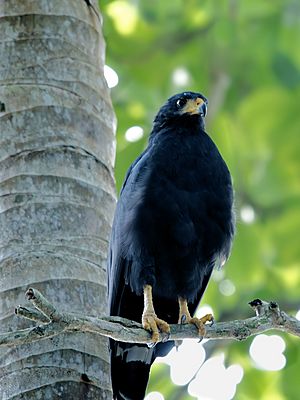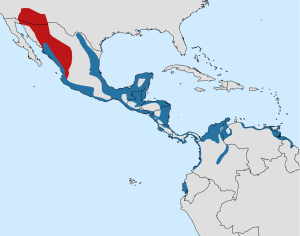Common black hawk facts for kids
Quick facts for kids Common black hawk |
|
|---|---|
 |
|
| Buteo. anthracinus subtilis | |
| Conservation status | |
| Scientific classification | |
| Genus: |
Buteogallus
|
| Species: |
anthracinus
|
| Subspecies | |
|
|
 |
|
The common black hawk (Buteogallus anthracinus) is a bird of prey in the family Accipitridae, which also includes the eagles, hawks, and Old World vultures. It formerly included the Cuban black-hawk (Buteogallus gundlachii) as a subspecies. The mangrove black hawk, traditionally considered a distinct species, is now generally considered a subspecies, B. a. subtilis, of the common black-hawk.
Contents
Description
The adult common black-hawk is 43–53 cm (17–21 in) long and weighs 930 g (33 oz) on average. It has very broad wings, and is mainly black or dark gray. The short tail is black with a single broad white band and a white tip. The bill is black and the legs and cere are yellow. The adults resemble zone-tailed hawks, but have fewer white bars on their tail and are larger in size.
Sexes are similar, but immature birds are dark brown above with spotting and streaks. Their underparts are buff to whitish with dark blotches, and the tail has a number of black and white bars.
Distribution and habitat
The common black-hawk is a breeding bird in the warmer parts of the Americas, from the Southwestern United States through Central America to Venezuela, Peru, Trinidad, and the Lesser Antilles. It is a mainly coastal, resident bird of mangrove swamps, estuaries and adjacent dry open woodland, though there are inland populations, including a migratory population in north-western Mexico and Arizona.
Behaviour
Breeding
The bird builds a platform nest of sticks fifteen to one hundred feet above the ground in a tree, often a mangrove. Nests are often reused and tend to grow bigger. It lays one to three eggs (usually one), which are whitish with brown markings.
Has hybridized naturally with Red-shouldered Hawk (Buteo lineatus) in Sonoma County, California, USA. This natural hybridization between different genera of hawks is rare.
Feeding
It feeds mainly on crabs, but will also take small vertebrates and eggs. This species is often seen soaring, with occasional lazy flaps, and has a talon-touching aerial courtship display. The call is a distinctive piping spink-speenk-speenk-spink-spink-spink.
Status and conservation
The common black hawk is protected in the far north of its range (in the USA) under the Migratory Bird Treaty Act of 1918.
- Common black hawk species account at Neotropical Birds (Cornell Lab of Ornithology)
See also
 In Spanish: Buteogallus anthracinus para niños
In Spanish: Buteogallus anthracinus para niños


